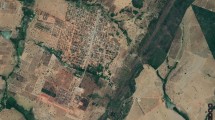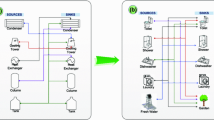Abstract
Purpose
Urban water cycle construction processes are an important element to consider when assessing the sustainability of urban areas. The present study focuses on a structural and environmental analysis of cylindrical water tanks. The goal is to optimise cylindrical water tanks from both an environmental (environmental impacts due of life cycle assessment (LCA)) and a geometric perspective (building material quantities for construction purposes depending on the tank characteristics).
Methods
A sample of 147 cases was defined based on different positions (buried, superficial and partially buried), dimensions (combinations of heights and radii) and storage capacities (between 100 and 10,000 m3). A structural analysis was conducted for a defined set of cases to determine the quantities of steel and concrete required for its construction. The environmental impacts of the entire life cycle were assessed through a life cycle assessment (LCA). Additionally, environmental standards (the less impactful option for each dimension assessed: geometry, storage capacity and position) defined in the study were applied to realistic cases to evaluate potential environmental savings.
Results and discussion
The LCA shows that materials are the main contributor to environmental impacts (more than transport, installation and end of life cycle stages). For this reason, the results of the structural and environmental assessments coincide. Taller water tanks have shown to be less impactful (60 to 70 % less impact for a 10.000-m3 tank). Regarding the position, superficial water tanks have shown to have between 15 and 35 % less impact than buried ones. The environmentally preferred water storage capacity is between 1000 and 2500 m3, being between 20 and 40 % less impact. For instance, an 8000-m3 tank would emit 1040 t of CO2 eq. Applying the environmental standards 170.5 t of CO2 eq could be saved (16 % of the total amount).
Conclusions
The results of this study show that among the cases analysed, superficially positioned cylindrical water tanks of 8.5 m in height and of between 1000 and 2500 m3 in storage capacity present fewer impacts. The use of these standards in municipal water tanks construction projects may significantly reduce environmental impacts (10 to 40 %) in all impact categories.









Similar content being viewed by others
Abbreviations
- ADP:
-
Abiotic depletion potential
- AP:
-
Acidification potential
- fctm:
-
Average tensile strength of the concrete
- B:
-
Buried
- CEDEX:
-
Centro de Estudios y Experimentación de Obras Públicas
- fck:
-
Compressive strength
- CED:
-
Cumulative energy demand
- C:
-
Cylindrical
- DWTDN:
-
Drinking water transport and distribution network
- Es:
-
Elastic modulus
- EP:
-
Eutrophication potential
- D:
-
Flexural rigidity
- GWP:
-
Global warming potential
- a:
-
Height
- ISO:
-
International Standard Association
- LCA:
-
Life cycle assessment
- w max :
-
Maximum crack width
- AS geom min :
-
Minimum geometric reinforcement amount
- AS mec min :
-
Minimum mechanical reinforcement amount
- E:
-
Modulus of elasticity
- ODP:
-
Ozone layer depletion
- PB:
-
Partially buried
- POCPPOCP:
-
Photochemical oxidation potential
- R:
-
Radius
- SLS:
-
Serviceability limit state
- Hs:
-
Soil height
- r nom :
-
Steel covering
- S:
-
Superficial
- ULS:
-
Ultimate limit state
- UNESCO:
-
United Nations Educational, Scientific and Cultural Organization
- UWC:
-
Urban water cycle
- EPA:
-
US Environmental Protection Agency’s
- Hw:
-
Water height
- fyk:
-
Yield strength
References
Agbar © (2013) http://www.agbar.es/en/home.html [Accessed on September 2013]
Amores MJ, Meneses M, Pasqualino J, Antón A, Castells F (2013) Environmental assessment of urban water cycle on Mediterranean conditions by LCA approach. J Clean Prod 43:84–92
Angrill S, Farreny R, Gasol CM, Gabarrell X, Viñolas B, Josa A, Rieradevall J (2011) Environmental analysis of rainwater harvesting infrastructures in diffuse and compact urban models of Mediterranean climate. Int J Life Cycle Assess 17(1):25–42
AWWA (American Water Works Association) (1995) Modeling, Analysis, and Design of Water Distribution Systems. AWWA, Denver, Colo
CEDEX, Centro de Estudios Hidrográficos (2009) Guía Técnica sobre tuberías para el transporte de agua a presión, sixth ed., ISBN 978-84-7790-492-2
CPH (2008) Instrucción del Hormigón Estructural EHE-08. Ministerio de Fomento, Madrid
Del Borghi A, Gaggero PL, Gallo M, Strazza C (2008) Development of PCR for WWTP based on a case study. Int J Life Cycle Assess 13(6):512–521
Del Borghi A, Strazza C, Gallo M, Messineo S, Naso M (2013) Water supply and sustainability: life cycle assessment of water collection, treatment and distribution service. Int J Life Cycle Assess 18(5):1158–1168
ecoinvent (2009) Swiss Centre for Life Cycle Inventories. Ecoinvent database v3.0. Technical report. http://www.ecoinvent.ch/ Accessed June 2014
Environmental Protection Agency (EPA) (2002) Finished Water Storage Facilities. PDF Document retrieved from http://water.epa.gov/lawsregs/rulesregs/sdwa/tcr/upload/2007_05_18_disinfection_tcr_whitepaper_tcr_storage.pdf
Friedrich E, Pillay S, Buckley CA (2009) Carbon footprint analysis for increasing water supply and sanitation in South Africa: a case study. J Clean Prod 17(1):1–12
Guinée JB, Gorrée M, Heijungs R, Huppes G, Kleijn R, Koning A de, Oers L van, Wegener Sleeswijk A, Suh S, Udo de Haes HA, Bruijn H de, Duin R van, Huijbregts MAJ (2002) Handbook on life cycle assessment. Operational guide to the ISO standards. I: LCA in perspective. IIa: Guide. IIb: Operational annex. III: Scientific background. Kluwer Academic Publishers, ISBN 1-4020-0228-9, Dordrecht, 692 pp
Guinée JB, Heijungs R, Huppes G, Zamagni A, Masoni P, Buonamici R, Ekvall T, Rydberg T (2011) Life cycle assessment: past, present, and future. Environ Sci Technol 45(1):90–96
Hospido A, Moreira MT, Feijoo G (2008) A comparison of municipal wastewater treatment plants for big centres of population in Galicia (Spain). Int J Life Cycle Assess 13(1):57–64
ISO 14040 (2006) Environmental management -- Life cycle assessment -- Principles and framework
Kellenberger D, Althaus HJ (2009) Relevance of simplifications in LCA of building components. Build Environ 44(4):818–825
Lassaux S, Renzoni R, Germain A (2007) Life cycle assessment of water: from the pumping station to the wastewater treatment plant. Int J Life Cycle Assess 12(2):118–126
Lemos D, Dias AC, Gabarrell X, Arroja L (2013) Environmental assessment of an urban water system. J Clean Prod 54:157–165
Llopart-Mascaró A, Farreny R, Gabarrell X, Rieradevall J, Gil A, Martínez M, Puerta J, Suárez J, del Río H, Paraira M (2014) Storm tank against combined sewer overflow: operation strategies to minimise discharges impact to receiving waters. Urban Water J 12(3):219–228
Mendoza J-MF, Oliver-Solà J, Gabarrell X, Rieradevall J, Josa A (2012) Planning strategies for promoting environmentally suitable pedestrian pavements in cities. Transport Res D-Tr E 17(6):442–450
Metabase Itec (2010) Online ITeC Database: Prices, Technical Details, Companies, Certificates, Product Pictures and Environmental Data. Retrieved from: http://www.itec.cat/metabase (accessed June 2014)
Muñoz I, Milà-i-Canals L, Fernández-Alba AR (2010) Life Cycle Assessment of Water Supply Plans in Mediterranean Spain. J Ind Ecol 14(6):902–918
Noori M, Kucukvar M, Tatari O (2013) A macro-level decision analysis of wind power as a solution for sustainable energy in the USA. Int J Sust Energy 34(10):629–644
Noori M, Kucukvar M, Tatari O (2014) Economic Input–Output Based Sustainability Analysis of Onshore and Offshore Wind Energy Systems. Int J Green Energy 12(9):939–948
Oliver-Solà J, Josa A, Rieradevall J, Gabarrell X (2009) Environmental optimization of concrete sidewalks in urban areas. Int J Life Cycle Assess 14(4):302–312
Orbe AM (2013) Optimización del uso de Hormigones Autocompactantes Reforzados con Fibras de Acero en Aplicaciones Convencionales de Resistencias Moderadas. Tesis Doctoral. Universidad del País Vasco, 2013
Petit-Boix A, Sanjuan-Delmás D, Gasol CM, Villalba G, Suárez-Ojeda ME, Gabarrell X, Josa A, Rieradevall J (2014) Environmental Assessment of Sewer Construction in Small to Medium Mid-sizedSized Cities Using Life Cycle Assessment. Water Resour Manag 28(4):979–997
Piratla KR, Asce SM, Ariaratnam ST, Asce M, Cohen A (2012) Estimation of CO 2 Emissions from the Life Cycle of a Potable Water Pipeline Project, (January), 22–30. doi:10.1061/(ASCE)ME.1943-5479.0000069
Riba Genescà E (2006) “Cálculo y elección óptima de un depósito de agua”. Director: Antonio Aguado. Universitat Politècnica de Catalunya. Departament de Resistència de Materials i Estructures a l’Enginyeria, Barcelona, 2006.
Sanjuan-Delmás D, Petit-Boix A, Gasol CM, Villalba G, Suárez-Ojeda ME, Gabarrell X, Josa A, Rieradevall J (2013) Environmental assessment of different pipelines for drinking water transport and distribution network in small to medium cities: a case from Betanzos, Spain. J Clean Prod 66:588–598
Sanjuan-Delmás D, Petit-Boix A, Gasol CM, Farreny R, Villalba G, Suárez-Ojeda ME, Gabarrell X, Josa A, Rieradevall J (2014) Environmental assessment of drinking water transport and distribution network use phase for small to medium-sized municipalities in Spain. J Clean Prod 87:573–582
Sharma AK, Grant AL, Grant T, Pamminger F, Opray L (2009) Environmental and Economic Assessment of Urban Water Services for a Greenfield Development. Environ Eng Sci 26(5):921–934
Spanish Ministry of Public Works (2008). EHE-08 Instrucción de Hormigón Estructural. ISBN: 978-84-498-0899-9
Stokes J, Horvath A (2011) Life-cycle assessment of urban water provision: tool and case study in California. J Infrastruct Syst 17(1):15–24
Takeuchi H, Asce M, Taketomi S, Samukawa S, Nanni A, Asce F (2004) Renovation of Concrete Water Tank in Chiba Prefecture, Japan. Practice Periodical on Structural Design and Construction, American Society of Civil Engineers Library. (November 2004), pp 237–241
United Nations Educational, Scientific, and Cultural Organization (UNESCO) (2012). Managing water under uncertainty and risk. In: The United Nations World Water Development Report 4, vol. 1. PDF document retrieved from: http://www.unesco.org/new/en/natural-sciences/environment/water/wwap/wwdr/wwdr4-2012/#c219661
Vargas-Parra MV, Villalba G, Gabarrell X (2013) Applying exergy analysis to rainwater harvesting systems to assess resource efficiency. Resour Conserv Recy 72:50–59
Venkatesh G, Brattebø H (2011) Energy consumption, costs and environmental impacts for urban water cycle services: case study of Oslo (Norway). Energy 36(2):792–800
Venkatesh G, Brattebø H (2012) Assessment of Environmental Impacts of an Aging and Stagnating Water Supply Pipeline Network. J Ind Ecol 16(5):722–734
Walski TM (2000) Hydraulic Design of Water Distribution Storage Tanks. In: Mays LW (ed) Chapter 10 in Water Distribution Systems Handbook. McGraw-Hill, New York. NY
Acknowledgments
The authors are grateful to the Government of Catalonia for awarding a research scholarship (FI-DGR 2014) to David Sanjuan Delmás and for its economic support of the research team (2014 SGR 1412).
The authors are also grateful for support provided by the Spanish Ministry of Education and Science through the BIA project (2010-20789-C04-01).
Author information
Authors and Affiliations
Corresponding author
Additional information
Responsible editor: Adriana Del Borghi
Electronic supplementary material
Below is the link to the electronic supplementary material.
ESM 1
(XLSX 66 kb)
Rights and permissions
About this article
Cite this article
Sanjuan-Delmás, D., Hernando-Canovas, E., Pujadas, P. et al. Environmental and geometric optimisation of cylindrical drinking water storage tanks. Int J Life Cycle Assess 20, 1612–1624 (2015). https://doi.org/10.1007/s11367-015-0963-y
Received:
Accepted:
Published:
Issue Date:
DOI: https://doi.org/10.1007/s11367-015-0963-y




